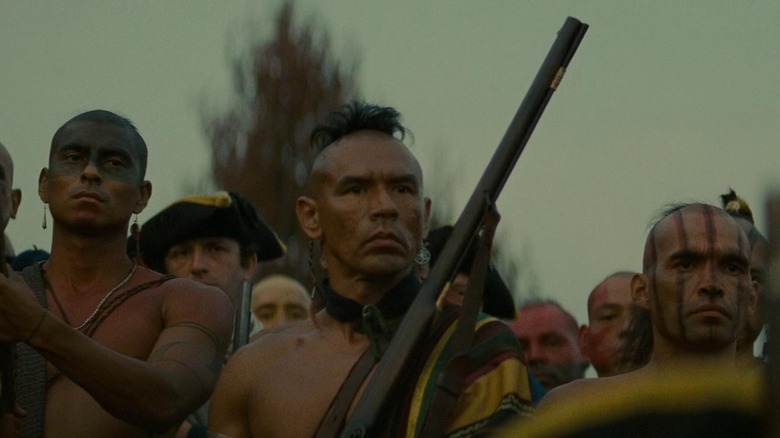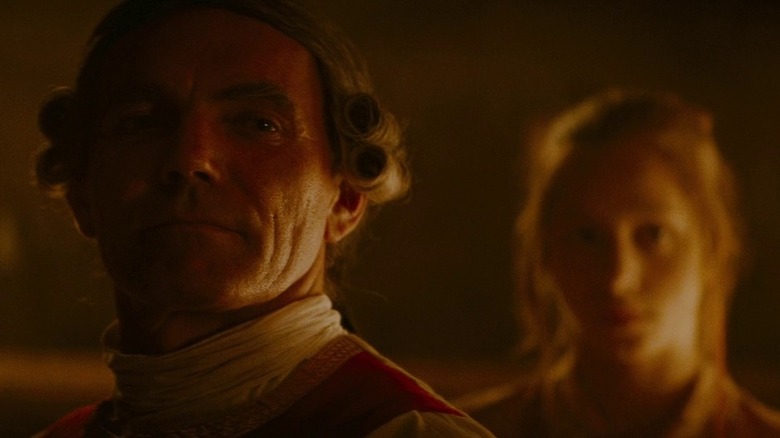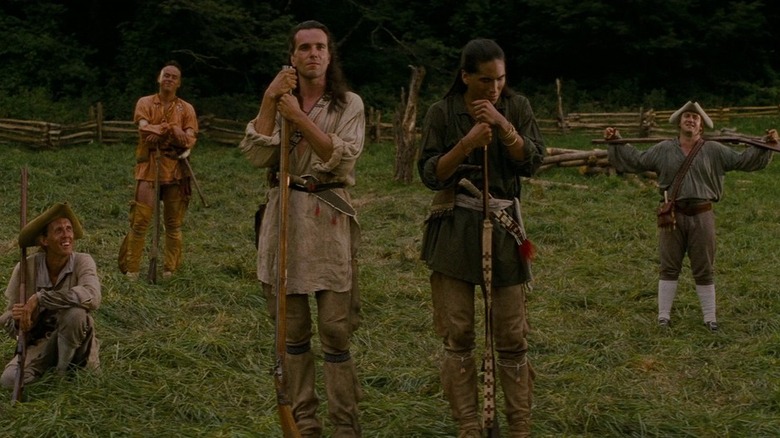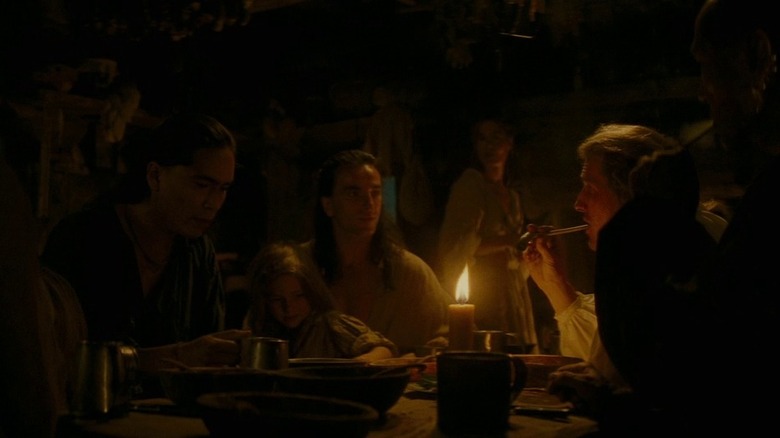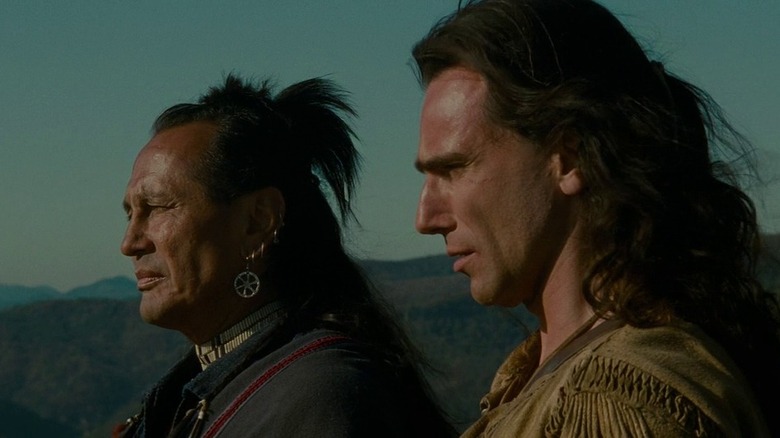Michael Mann Had To Get Creative When Adapting The Last Of The Mohicans
"The Last of the Mohicans" is a potboiler written by James Fenimore Cooper and published in 1826. It tells the tale of Natty Bumppo, a white man raised by Native Americans who goes on rollicking adventures across the frontier. "The Last of the Mohicans" is book two of a five-part series, like if "Star Trek II: The Wrath of Khan" was spectacularly boring and also required reading for American students. Yet it has been adapted to film and television many times. George B. Seitz directed a version in 1936. Michael Mann, legendary director of "Heat" and "Miami Vice," directed his own version in 1992. Cary Fukunaga and Nicole Kassell were announced to be working on a new adaptation back in 2020. Something in the source text has lured in artists again and again, like moths fluttering inexorably toward an old and unpredictable camp lantern.
In an interview with Hitfix, Mann confesses that his first experience with "The Last of the Mohicans" was the aforementioned 1936 film by Seitz. Two splinters lodged in his brain as a child. The first was a memory of suicide, likely related to romantic heroines Cora and Alice Munro. The second was the shock of seeing Native Americans interacting with the British instead of cowboys, and in the northeast instead of the American West. Mulling over these memories in 1991, years after his previous film "Manhunter," Mann decided he would tackle his childhood nostalgia head-on and direct a new version of "The Last of the Mohicans."
Building Fort William Henry, stone by stone
Michael Mann brought his obsessive attention to detail to bear on the story of Natty Bumppo. The cast and crew hiked across North Carolina mountains to shoot scenes on location. They constructed an enormous set for Fort William Henry, a key location around which the story revolves. Lead actor Daniel Day-Lewis trained rigorously every day so as to become as strong and capable as Bumppo. In the eyes of Mann, Lewis' admittedly grueling process was the ideal. After all, as Mann told Hitflix: "if an actor can actually do the things of the person he's portraying, he truly becomes that person." Mann sought to do the same for the world of his film. There was only one problem — according to Mann, "The Last of the Mohicans" was a bad book. He continued to Hitflix:
"James Fenimore Cooper had vast real estate holdings in 1825 when he wrote the book. So the novel is almost a justification for a massive land grab ... that the Euro-Americans will be a better steward of the riches that God bestowed upon American Indians."
A fan of the novel might argue its central theme is the displacement and death of Native Americans at the hands of white settlers. Would that not mean that 'The Last of the Mohicans" is written in support of the Mohicans? Not quite, says Hugh MacDougall, the founder of the James Fenimore Cooper Society. Cooper took the time to research contemporary sources on Native Americans as well as on the history of the French and Indian War. But according to MacDougall, the novel still argues in favor of settler colonialism and assumes the extinction of Native American tribes like the Mohicans is inevitable.
James Fenimore Cooper's lie
Most damningly of all, the very title of the book is a misnomer. "The Last of the Mohicans" purports to retell the death of the last Mohican, but the Mohicans are still alive today. Perhaps James Fenimore Cooper's conclusion in the book was a simple mistake based on flawed research. But Hugh MacDougall insists Cooper "knew perfectly well there were still Mohicans living."
Rather than an elegiac tale of a people doomed by greed, "The Last of the Mohicans" is instead an ahistorical fantasy concocted by a pulp writer whose audience took his words for gospel because they didn't know any better. It's enough to drive folks like Molly Miller, the chairwoman of the Stockbridge-Munsee Community Band of Mohican Indians, up a wall. "When we talk about it, we laugh at it because it's so wrong," she told Indian Country Today. "We're still here."
Clearly, Michael Mann had his work cut out for him in order to rescue "The Last of the Mohicans." Thankfully, he had a secret weapon in the diary of Louis Antoine de Bougainville, the man who named the flower bougainvillea. Bougainville wrote a diary that "literally told us what happened every single day of August 1757," Mann told Hitflix. All they had to do was rework Cooper's racist assumptions with primary source history. Other changes were made to modernize the source material for audiences in the 1990s. The dark-haired and independent Cora is promoted from sacrificial lamb to romantic heroine and given a subplot meant to demonstrate the opportunities offered by the American frontier that life in Britain could not provide. The character of Magua, a straightforward villain in the novel, is made more complex by the virtue of talented actor Wes Studi. Even the hero, Natty Bumppo, is given the more traditional action hero nickname "Hawkeye."
Stories of resilience and survival
Roger Ebert said in his review that "The Last of the Mohicans" was "more of a matinee fantasy than it wants to admit — but is probably more entertaining as a result." Certainly, the movie is as much a pulpy '90s action blockbuster as it is the minutely detailed historical epic promised by Michael Mann's team. It is still more enjoyable than the source text, if only because the cast commits so fully to the material. Mann has also been tweaking the film over the past several years, cutting material from the theatrical and video editions that didn't quite work. If the film doesn't enjoy the same cultural cachet as "Heat," it isn't an embarrassment either.
But is that enough? Mann and his team may have tried, with the best of intentions, to rectify Cooper's errors. Yet the film is still titled "The Last of the Mohicans," an ahistorical lie. In an opinion piece for High Country News, award-winning theater director, assistant English professor and Mohegan descendant Madeline Sayet expresses her frustration with Cooper's continued popularity. She references works like Tommy Orange's novel "There There" as the kind of story she wants to see in the world, a story "of resilience and survival ... instead, 'The Last of the Mohicans' will continue to tell us that we don't exist," she wrote.
Meanwhile, in an episode of the recurring feature "Mannhunting" as part of subscription podcast Waypoint Radio Plus, cultural critic Dia Lacina gets at the fundamental contradiction at the heart of "The Last of the Mohicans." The film and its source material might forecast the extinction of Native Americans at the hands of colonists, but the film itself is loaded with talented Native American actors without which the film would be nothing.
There have always been Mohicans
Cary Fukunaga and Nicole Kassell's "Last of the Mohicans" remains in production. Perhaps they will find a new take on the material that eluded even Mann. But so many other great novels by Native American writers are crying out for adaptation. "There There" is one, but so are Stephen Graham Jones' "The Only Good Indians," Leslie Marmon Silko's "Almanac of the Dead," and the extensive back catalog of novelist Louise Erdrich. I can't say when Hollywood might acknowledge the multiplicity of these voices and give Indigenous directors and writers the chance to build these stories from the ground up. But if it ever happens, the result could leave the work of James Fenimore Cooper in the dust. It might even beat out Michael Mann.
